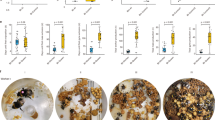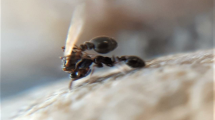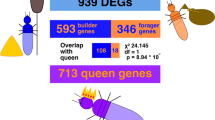Abstract
A fundamental goal of sociobiology is to explain how complex social behaviour evolves1, especially in social insects, the exemplars of social living. Although still the subject of much controversy2, recent theoretical explanations have focused on the evolutionary origins of worker behaviour (assistance from daughters that remain in the nest and help their mother to reproduce) through expression of maternal care behaviour towards siblings3,4. A key prediction of this evolutionary model is that traits involved in maternal care have been co-opted through heterochronous expression of maternal genes5 to result in sib-care, the hallmark of highly evolved social life in insects6. A coupling of maternal behaviour to reproductive status evolved in solitary insects, and was a ready substrate for the evolution of worker-containing societies3,4,7,8. Here we show that division of foraging labour among worker honey bees (Apis mellifera) is linked to the reproductive status of facultatively sterile females. We thereby identify the evolutionary origin of a widely expressed social-insect behavioural syndrome1,5,7,9, and provide a direct demonstration of how variation in maternal reproductive traits gives rise to complex social behaviour in non-reproductive helpers.
This is a preview of subscription content, access via your institution
Access options
Subscribe to this journal
Receive 51 print issues and online access
$199.00 per year
only $3.90 per issue
Buy this article
- Purchase on Springer Link
- Instant access to full article PDF
Prices may be subject to local taxes which are calculated during checkout


Similar content being viewed by others
References
Robinson, G. E., Grozinger, C. M. & Whitfield, C. W. Sociogenomics: social life in molecular terms. Nature Rev. Genet. 6, 257–270 (2005)
Wilson, E. O. & Hölldobler, B. Eusociality: origin and consequences. Proc. Natl Acad. Sci. USA 102, 13367–13371 (2005)
West-Eberhard, M. J. in Animal Societies: Theories and Fact (eds Itô, Y., Brown, J. L. & Kikkawa, J.) 35–51 (Japan Sci. Soc. Press, Tokyo, 1987)
West-Eberhard, M. J. in Natural History and Evolution of Paper Wasp (eds Turillazzi, S. & West-Eberhard, M. J.) 290–317 (Oxford Univ. Press, New York, 1996)
Linksvayer, T. A. & Wade, M. J. The evolutionary origin and elaboration of sociality in the aculeate Hymenoptera: Maternal effects, sib-social effects, and heterochrony. Q. Rev. Biol. 80, 317–336 (2005)
West-Eberhard, M. J. Developmental Plasticity and Evolution (Oxford Univ. Press, New York, 2003)
Amdam, G. V., Norberg, K., Fondrk, M. K. & Page, R. E. Reproductive ground plan may mediate colony-level selection effects on individual foraging behaviour in honey bees. Proc. Natl Acad. Sci. USA 101, 11350–11355 (2004)
Hunt, J. H. & Amdam, G. V. Bivoltinism as an antecedent to eusociality in the paper wasp genus Polistes. Science 308, 264–267 (2005)
Page, R. E. & Erber, J. Levels of behavioural organization and the evolution of division of labour. Naturwissenschaften 89, 91–106 (2002)
Seeley, T. D. The Wisdom of the Hive (Harvard Univ. Press, Cambridge, Massachusetts, 1995)
Robinson, G. E. Regulation of division of labour in insect societies. Annu. Rev. Entomol. 37, 637–665 (1992)
Winston, M. L. The Biology of the Honey Bee (Harvard Univ. Press, Cambridge, Massachusetts, 1987)
Rueppell, O., Pankiw, T. & Page, R. E. Pleiotropy, epistasis and new QTL: The genetic architecture of honey bee foraging behaviour. J. Hered. 95, 481–491 (2004)
Page, R. E. & Fondrk, M. K. The effects of colony-level selection on the social organization of honey bee (Apis mellifera L.) colonies: colony-level components of pollen hoarding. Behav. Ecol. Sociobiol. 36, 135–144 (1995)
Dunn, T. & Richards, M. H. When to bee social: interactions among environmental constraints, incentives, guarding, and relatedness in a facultatively social carpenter bee. Behav. Ecol. 14, 417–424 (2003)
Simonet, G. et al. Neuroendocrinological and molecular aspects of insect reproduction. J. Neuroendocrinol. 16, 649–659 (2004)
Min, K. J., Taub-Montemayor, T. E., Linse, K. D., Kent, J. W. & Rankin, M. A. Relationship of adipokinetic hormone I and II to migratory propensity in the grasshopper, Melanoplus sanguinipes. Arch. Insect Biochem. Physiol. 55, 33–42 (2004)
Spieth, J., Nettleton, M., Zuckeraprison, E., Lea, K. & Blumenthal, T. Vitellogenin motifs conserved in nematodes and vertebrates. J. Mol. Evol. 32, 429–438 (1991)
Capella, I. C. S. & Hartfelder, K. Juvenile hormone effect on DNA synthesis and apoptosis in caste-specific differentiation of the larval honey bee (Apis mellifera L.) ovary. J. Insect Physiol. 44, 385–391 (1998)
Tatar, M. & Yin, C. M. Slow aging during insect reproductive diapause: why butterflies, grasshoppers and flies are like worms. Exp. Gerontol. 36, 723–738 (2001)
Tu, M. P. & Tatar, M. Juvenile diet restriction and the aging and reproduction of adult Drosophila melanogaster. Aging Cell 2, 327–333 (2003)
Tanaka, E. D. & Hartfelder, K. The initial stages of oogenesis and their relation to differential fertility in the honey bee (Apis mellifera) castes. Arthropod Struct. Dev. 33, 431–442 (2004)
Hodin, J. & Riddiford, L. M. Different mechanisms underlie phenotypic plasticity and interspecific variation for a reproductive character in drosophilids (Insecta: Diptera). Evolution 54, 1638–1653 (2000)
Hartfelder, K., Bitondi, M. M. G., Santana, W. C. & Simões, Z. L. P. Ecdysteroid titer and reproduction in queens and workers of the honey bee and of a stingless bee: loss of ecdysteroid function at increasing levels of sociality? Insect Biochem. Mol. Biol. 32, 211–216 (2002)
Maurizio, A. Pollenernahrung und Lebensvorgange bei der Honigbiene (Apis mellifera L.). Landwirtsch. Jahrb. Schweiz. 245, 115–182 (1954)
Hartfelder, K., Köstlin, K. & Hepperle, C. Ecdysteroid-dependent protein synthesis in caste-specific development of the larval honey bee ovary. Rouxs Arch. Dev. Biol. 205, 73–80 (1995)
Butler, C. G. The control of ovary development in worker honeybees (Apis mellifera). Experientia 13, 256–257 (1957)
Bloch, G., Wheeler, D. & Robinson, G. E. in Hormones, Brain and Behavior (eds Pfaff, D., Arnold, A. P., Etgen, A. M., Fahrbach, S. E. & Rubin, R. T. ) 195–235 (Academic, San Diego, 2002)
Robinson, G. E. & Ben-Shahar, Y. Social behaviour and comparative genomics: new genes or new gene regulation? Genes Brain Behav. 1, 197–203 (2002)
Gary, N. E. & Lorenzen, K. A method for collecting the honey-sac content from honeybees. J. Apic. Res. 15, 73–79 (1976)
Acknowledgements
We thank A.L.O.T. Aase for assistance with dissections, and K. Hartfelder and P. Kukuk for comments. The project was supported by grants from the Norwegian Research Council to G.V.A, and from the National Institute on Aging and the National Research Initiative of the USDA Cooperative State Research, Education and Extension Service to R.E.P.
Author information
Authors and Affiliations
Corresponding authors
Ethics declarations
Competing interests
Reprints and permissions information is available at npg.nature.com/reprintsandpermissions. The authors declare no competing financial interests.
Supplementary information
Supplementary Tables
Supplementary Table 1 and 2. Detailed results on ovary size (number of ovary filaments) and state of ovarian activation in honey bee workers of strains selected for high- or low levels of pollen collection and storage. (DOC 142 kb)
Rights and permissions
About this article
Cite this article
Amdam, G., Csondes, A., Fondrk, M. et al. Complex social behaviour derived from maternal reproductive traits. Nature 439, 76–78 (2006). https://doi.org/10.1038/nature04340
Received:
Accepted:
Issue Date:
DOI: https://doi.org/10.1038/nature04340
This article is cited by
-
Mechanisms for polyandry evolution in a complex social bee
Behavioral Ecology and Sociobiology (2024)
-
Arylalkylamine N-acetyltransferase activity parallel to work types and their temporal shift suggests its involvement in polyethism regulation in Apis mellifera workers
Apidologie (2023)
-
Resource sharing is sufficient for the emergence of division of labour
Nature Communications (2022)
-
Ovary activation correlates with the reproductive potential of honeybee (Apis mellifera) workers if they are in a foreign colony
Insectes Sociaux (2022)
-
Segmentation of the subcuticular fat body in Apis mellifera females with different reproductive potentials
Scientific Reports (2021)
Comments
By submitting a comment you agree to abide by our Terms and Community Guidelines. If you find something abusive or that does not comply with our terms or guidelines please flag it as inappropriate.



